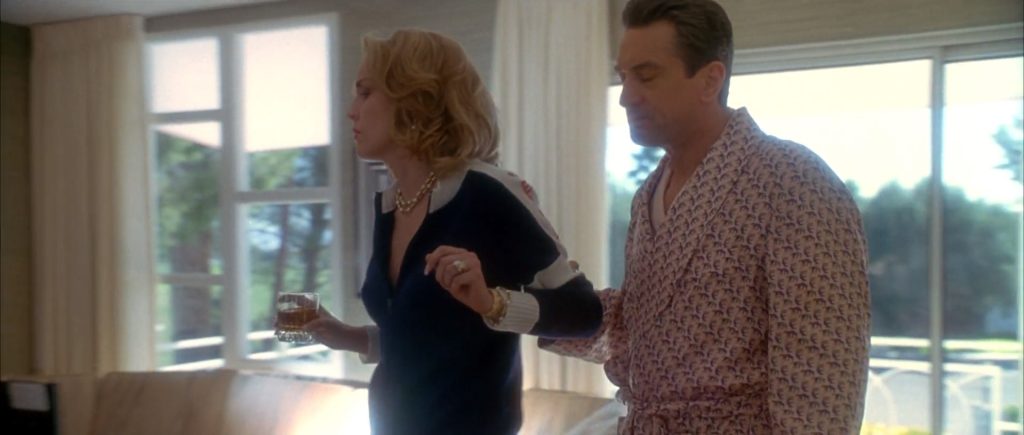Leaving Las Vegas (1995): : A Hauntingly Poignant Tale of Despair and Connection – Film Review

“Leaving Las Vegas,” directed by Mike Figgis and released in 1995, stands out as a profoundly moving film, delving into themes of addiction, loneliness, and the desperate search for connection. Starring Nicolas Cage and Elisabeth Shue in career-defining roles, the film paints a bleak yet deeply human portrait of two lost souls in Las Vegas. This review explores the film’s narrative strengths, character portrayals, behind-the-scenes aspects, and its poignant musical score.
Narrative and Thematic Depth: Exploring the Darkness of the Human Soul
Based on the semi-autobiographical novel by John O’Brien, “Leaving Las Vegas” follows the story of Ben Sanderson (Nicolas Cage), a self-destructive alcoholic who loses everything and decides to move to Las Vegas to drink himself to death. There, he forms an unlikely relationship with Sera (Elisabeth Shue), a kind-hearted prostitute with her own set of troubles. The narrative is a raw and unflinching look at the lives of people on the fringes of society, dealing with themes of addiction, despair, and the human need for connection.
The film refuses to shy away from the harsh realities of its characters’ lives, offering no easy answers or solutions. Instead, it presents their journey with brutal honesty, making it a powerful and emotionally resonant experience.
Behind the Scenes: Bringing the Story to Life
“Leaving Las Vegas” was a labor of love for director Mike Figgis, who also wrote the screenplay and composed the film’s score. The film was made on a modest budget, which necessitated a lean and efficient approach to production. Figgis’s commitment to maintaining the integrity of O’Brien’s story was evident in his directorial choices, from the gritty, realistic portrayal of Las Vegas to the use of hand-held cameras that lend an intimate, almost voyeuristic feel to the film.
The production faced its set of challenges, including shooting in the actual locations in Las Vegas, which added authenticity to the film but also required careful coordination and planning.
Performances: Cage and Shue’s Raw and Vulnerable Portrayals
Nicolas Cage’s performance as Ben is a tour de force, earning him an Academy Award for Best Actor. He portrays Ben’s self-destructive spiral with a raw intensity that is both harrowing and deeply moving. Cage’s commitment to the role, including physically transforming himself and delving deep into the psyche of an alcoholic, brought a staggering authenticity to his performance.
Elisabeth Shue’s portrayal of Sera is equally powerful. She brings a sense of resilience and compassion to the character, making her more than a mere foil to Ben. Shue’s nuanced performance, which earned her an Oscar nomination, captures the complexity of a woman who finds strength and vulnerability in her relationship with Ben.
The Score: Enhancing the Film’s Emotional Impact
The film’s score, composed by Mike Figgis, is an integral part of its emotional landscape. The music, with its melancholic jazz tones, perfectly complements the film’s somber mood. The score is both haunting and beautiful, underscoring the film’s exploration of love, pain, and despair.
Themes: The Search for Redemption and Connection
“Leaving Las Vegas” delves deeply into themes of redemption and the human need for connection. The film portrays its characters without judgment, allowing their story to unfold with empathy and depth. The relationship between Ben and Sera is portrayed with a poignant sincerity, highlighting their mutual need for understanding and acceptance.
The film also explores the darker aspects of addiction, not just as a physical dependence but as a means of escape from personal demons. It’s a meditation on the lengths people go to find solace, however fleeting it may
be, and the impact of human connection in the midst of despair.
Cultural Impact and Reception
Upon its release, “Leaving Las Vegas” was acclaimed for its unflinching portrayal of addiction and its emotional depth. The film struck a chord with audiences and critics alike for its honest and compassionate exploration of difficult themes. It has since been regarded as a seminal film in the genre of dramatic storytelling, noted for its impact on portrayals of addiction in cinema.
The film’s success also marked a significant point in the careers of Nicolas Cage and Elisabeth Shue, showcasing their range as actors and their ability to imbue their characters with a profound sense of humanity.
Cinematography: Capturing the Grit and Glitz of Las Vegas
The cinematography, helmed by Declan Quinn, plays a crucial role in setting the tone of the film. The contrast between the glitzy, neon-lit Las Vegas strip and the stark, desolate backgrounds of the characters’ lives is captured with a gritty realism. The use of lighting and color palette in the film enhances the thematic contrasts between the allure of the city and the harsh realities of the characters’ existence.
“Leaving Las Vegas” is a film that remains etched in the viewer’s mind long after the credits roll. Its portrayal of two people finding solace in each other amid their individual despair is both heartbreaking and deeply humane. The film stands as a poignant reminder of the power of cinema to explore the darker aspects of life with empathy, complexity, and an unyielding commitment to emotional truth. The performances by Nicolas Cage and Elisabeth Shue, combined with the unforgettable score and the film’s raw depiction of Las Vegas, make “Leaving Las Vegas” an enduring piece of cinematic artistry.




